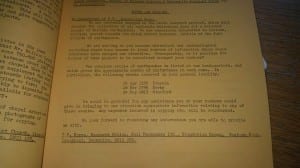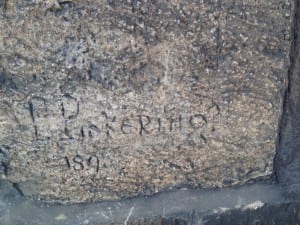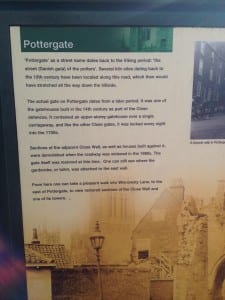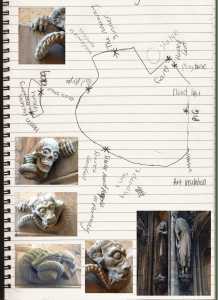Framing Statement
“Site-specific performance – acts of theatre and performative events at landscape locations, in village streets, in urban situations. In houses, chapels, barns, disused factories, railway stations; on hillsides, in forest clearings, underwater. At the scale of civil engineering; as intimate as a guided walk.” (Palgrave Macmillan, 2010)
My understanding of site specific work is that you either pick a site or are granted a site to work in and with this you look at the site, the history within that site and with the information you gather you think about how you can create a piece of theatre that will, inform, or question your audience or even create a piece which will gather a new kind of audience which wouldn’t usually see that style of theatre.
When given Steep Hill and the whole of Bailgate to work with its amazing to let your imagination wander to the different points of history which you believe you know as well as let yourself wander the lengths even if you find new places which you were unaware of. Starting off we looked at key points off interest throughout the group:
- Exploring the senses – Heightening and Blocking
- Using Audio, Video or picture
- Abstract, concentrate on energy
- Cathedral (choir)
- Playing with heights
- RAF
- Pathways/footprints
- Video of site
- Subtle mob – video pin point participants
- History
- Suggestive
- Different experiences.
We decided collectively to explore some of these aspects as we explored the top of the hill more so we could see which points we felt were going to be more effective to work with.
Throughout the process I have had a great admiration for the work of Janet Cardiff, the way she incorporates the past, the present and the future into her pieces, its almost like a capsule of time. Every memory is overlapped by another, so what if you can walk across them all while being introduced to different aspects of each of them. Cardiff also uses audio in an imaginative way as she over lays each time, such as her work Memory Walk (Link- http://www.cardiffmiller.com/artworks/walks/jena.html) the diary extracts read over the sounds of a battle ground and then also tanks following, each time period is heard yet one is more distinct than the other.
The Cathedral has faced a number of significant obstacles through the years since it was first built, however not everyone knows just how much it has taken for it to still be standing to this day. Therefore with the influence of Janet Cardiff’s work the audio walk of Disturbance was created, showing the 1185 earthquake which carried the fall of part of the Cathedral.
However the idea followed that the audio would emit a normal day up Bailgate with children shouting in the street, conversations being heard, the sound of horses in the street, of shop doors opening and buskers in the street, slowly building up, church bells ringing then eventually turmoil begins when the rumbles become too loud and violent to not acknowledge, and as you are looking at the Cathedral you can hear the crashing of rocks and stone around you, until a silence emits and eventually a letter is read out inviting anymore information about the 1185 earthquake to be given to Lincoln council.
These ideas then led to the performance which occurred on the 6th of May 2015 which occurred for 11 minutes and 15 seconds (audio walk); however with the starting speech and any queries or answering questions at the end the overall performance was generally 15 minutes.
Analysis of Process
Taking inspiration from Prototype and their idea of games within theatre, specifically looking at their installation Through the Wall which was a six channel video and poetic audio instillation, looking at the inspiration behind the surface of Chester walls and how there is the potential to re-orientate the flow of movement through and into the history of the walls, set on the Roman Walls within the Roman Gardens. Through looking at this we thought about orientation, and how this can affect a persons perspective on something or even change their ideas on an object, or an idea or maybe something that has already occurred. Can you twist someone’s perspective? With this idea in mind we thought about how we could integrate the idea of past present and future initiated by Janet Cardiff by re- orientating our audience’s perspectives.
Also inspired by Blast Theory, specifically looking at their game Uncle Roy All Around You, we looked into the idea of stylising two or three games which would interlink into one another and would cross paths at various points. Uncle Roy All Around You looked into the idea of digitalisation and the real world,
“blurring of fictional and real experiences” (Adams, 2006, 2)
Within our generation now we often rely on technology as a central relationship and we lose contact with what is real city spaces and which are virtual, this becomes clear through this game as different questions are asked to the ‘live’ player and ‘online’ players and at different points players work out that the answers they give affects the game they play. We often lose reality through technology, so what if we do the opposite, what if we exemplify and accentuatereality through audio?
Using the Bailgate as a base we looked further into the history of the RAF, Army and Navy which had been a point of interest for everyone.
In the Cathedral there were numerous flags as well as the names of people who were in the Army, RAF and Navy who fell during the war. In one of our audio games we want it to be as if the players are in a war, the sounds, the moves, each game will interlink however it will be in different ways. For instance in this game the players may be told that the person next to them is an enemy trying to attack them, however the person in that game may have been told to try and make friends with that person and stick by them therefore they have to try and solve this problem.
We wanted the Cathedral as a base for a beginning and an end as we love:
- The echo of voices you hear inside
- The design of the windows
- The prayers that are made
- Thoughts that are given
- What was made in the War
We hoped to end the 3 games link in the church listening to the choir singing, as each voice radiates against the walls its so pure and delicate, we believed we could create a small story within this about how each step and each footpath was led to this destination where all thoughts are free, and everyone can be welcomed as well as forgiven for what they have done, or even guided to where they may want to be.
We would like to open people’s eyes to the opportunity of following different footpaths which they are told to, and then given the light to create their own. It’s interesting to look at the perception of each and every person and how one can change their perception, as well as how perceptions can change from one person to another. However do we truly think about how this may affect someone else? It is shown that people are more likely to care when the decisions that they make influence others, they feel connected as well as having a sense of empowerment.
Although we really liked this idea, looking at how appropriate it would be we soon found many obstacles, including the fact that there wasn’t an actual RAF base in Lincoln or up Steep Hill itself to face and we found ourselves on a slightly different route thinking more along the lines of just the one route, going more down the path of the 1185 Earthquake that occurred in Lincoln. Although this was a major natural disaster that occurred there is very little information kept on it, and not a lot of people actually know that it occurred, and the extent in which the damage it made. Therefore we went on an adventure to find out as much information as we could, I believe some of the best pieces of evidence we found was from Lincoln Library in which we found letters which had been written by the council and members of the public as well as a date book which stated:
“An earthquake which overthrew a Church and
did considerable damage to the Cathedral, of
which Benedict, the Abbot of Peterborough says,
the like had not been heard in England: –
That the rocks were rent, and the Cathedral
Church of Lincoln was cleft from top to bottom
….” (The Date Book, 31)
Prototype’s idea of orientation soon cropped up again within our idea here as we could use the idea of re-orientation and playing with people’s perspectives to place the idea of an earthquake happening now.
I took inspiration from Hamish Fulton and his idea behind,
“I am an artist who walks, not a walker who makes art”
(Marsh, 2012, 8)
Fulton looked into the body of work behind walking as an art form. The method of walking is often seen as one where you can create art through walking if you do something along the way, however Fulton sees walking as being part of the art in itself,
“The belief in walking as an art form in its own right.”
(Marsh, 2012, 8)
I found this interesting as a lot of people find themselves walking to get to a destination, however what if you just walk without an end result, without an idea in mind as to where to go , would that make a difference, would it lengthen the journey? Would it be as interesting, or maybe more interesting as there would be the sights to focus on as you walked along.
I feel that this physical idea could be incorporated into our audio within our route as we want our route to carry a simple path yet encourage a concentration from our audience so they view the sights they go past while listening to the audio incorporating what they hear to what they see. In this case would a simple path then allow our audience to walk as artists feeling the piece they are hearing and their surroundings, therefore allowing them to engage fully in the process.
Our Designated Route
Our route started before Newport Arch, and ended going through Exchequer Gate and standing at the Cathedral, we wanted the arch’s to act as a tunnel to venture through and to think about the start and the finishing of different times, as I was going to read the history of each Arch before the audience embarked on the audio walk I felt this would echo the idea of past, present and future aspects which we wanted the audience to identify throughout the piece. Especially Newport Arch as it is th e most famous Roman remains in Lincoln as well as the best preserved, but it is also the only Roman Arch still in use for daily transportation. So the use of the Arch in itself shows how one place was used many years ago yet is still to this day such an important part of our society.
e most famous Roman remains in Lincoln as well as the best preserved, but it is also the only Roman Arch still in use for daily transportation. So the use of the Arch in itself shows how one place was used many years ago yet is still to this day such an important part of our society.
(Geograph, 2006)
Janet Cardiff stated:
“Walking is very calming. One step after another,
one foot moving into the future and one in the
past. Did you ever think about that? Our bodies
are caught in the middle. The hardest part is
staying in the present. Really being here.”
(Cardiff 2004: Her Long Black Hair)
(Nedelkopoulou, 2011)
Cardiff emphasises the different states of past, present and future and how each can interlink, people dream about the future, they reminisce about the past, however they find it hard to live each day as it is. We want our audio walk to mix the different capsules of time, yet to make the audience think about how they would feel if such a disaster happened now.
- How would they cope?
- How would they feel?
- Where would they go?
We want each question to echo around their minds as they are thrown from feeling they are in one world to then finding out about the natural disaster which occurred in 1185.
Audio
Creating the audio has been a constant tackle, with having to record most of it ourselves and then putting it together sometimes it did not overlay right, and therefore the audience would not get the full effect of what we were trying to create. Constantly going back to the start to try and recreate certain parts, however once we established a grounding point that we would have such instalments as:
- Shop doors opening
- Footsteps
- Cars
- Music (from buskers)
- The Cathedral bells
- By passers talking
We were then able to start layering each part to see what fit and what needed rethinking, then once we had the initial audio we could start introducing the rumbles which would create a build up to the final grand moment.
Its interesting sitting in one place and hitting record, you never know the extent of the sounds or noises that you will pick up, the music from the buskers, the questions that you are asked from strangers, the squeals from children as they run past, the snippets of conversations you over hear. Even sitting for the minimal 5 minutes its amazing the sounds that are collected, as we did this each time we found something new which could be used within the audio adding a new focal point for the audience to be captured by along the walk. We wanted certain noises to almost distract our audience so we added in conversations or squeals which were louder to make it seem as if they were right next to the audience member hoping they would turn to see, as well as a door opening and a bike going past ringing a bell therefore the participant would hopefully keep a look out for each different occurrence.
Each dress rehearsal showed us something new to change, however we had the repetitive comment of needing more build up as the moment at the end although piercing was almost a shock but not in the right way and we know what was happening, so for an audience which did not understand we did not feel this would work. The build up needed to be subtle but still there, so we created a list of minutes where there needed to be rumbles:
- 2:30-3
- 4:00
- 6:00
- 8:30
- 10:10
https://www.youtube.com/watch?v=IYCMGL2QHTw&feature=youtu.be (audio link)
With these rumbles added in the build up seemed to work better, we also added in some speech at the beginning and the end. The beginning speech although not mentioning earthquakes it described what happened when an earthquake occurs. So it gives the audience a glimpse ass to what is going to occur through the audio walk, however it does not give too much away. Then at the end one of the letters which we found in the library asking for any information to be recalled is read out, the letter mentions the earthquake which occurred in 1185. We felt this would allow the audience to understand the audio they had just heard, and then they could fit together everything they had been told and the walk they had just done and why at the end they were looking at the cathedral.
Performance Evaluation
Performance day was one of both relief and terror, we took time out before the actual performance to make sure that the audio worked, that we all knew where each member of the group would be, and what our parts were. As the first person the audience members would see and speak to I knew I needed to make sure I was friendly and approachable, although the weather showed difficult through wind and rain we persevered for the 2 hours we were there however, audience members were less persistent with only 5 appearing, 2 being the assessors.
What did work well was that each member seemed to come at different times so I could stagger them through the walk meaning they could really involve themselves in the process, rather than getting distracted by other members of a group.
I started the walk off with some history about Newport Arch where they would be crossing under to follow the path down to Castle square where they would turn to then go under Exchequer Gate and eventually end the audio looking at the Cathedral. The comments we were granted were that the end moment was breath taking; it gave people goose bumps which was a positive comment to hear as the disaster that occurred was disturbing, and occurred to an incredibly huge scale, therefore for us to create the end moment which built to that extremity was very rewarding. We were also told that we had created a piece of work that most members of the audience had never experienced before, so they were able to experience a new type of performance where they were actually involved as not only the audience members but also the performers in an audio walk as the expressions on their faces, the way that they walked, the pace, the movements and each time they stopped to look at a different space was part of the performance.
I fear because of the small sample of audience which got to participate with our audio walk we did not get the coverage we expected, and therefore did not truly see the reactions of our audience, as one person reacts differently to another. Also the idea of a continuous line of audience members would have been very interesting as it would have meant audience members had others to follow to see they were not alone, hopefully within this would have fully committed to what they had been asked to do, as well as what they were listening to.
If I were to do this specific audio walk again I would definitely rethink the route taken as I feel it needed to be slightly longer as well as covering areas in which would cause more people to turn and look.
The idea was thought of to let audience members search their own paths and therefore end up at their own destinations for the end result, however there is a fear held in this that some would go straight back down steep hill and not listen properly to the surrounding sounds on the audio. A step that could be taken to rethink this process would be an instruction I learned from looking at Janet Cardiff’s work where she would almost constantly be with the walkers on their path as certain stages the audio would almost pause, and she would talk to them as if she was their with them, whether it was to assure them of where they were, or tell them a route to go, or instructing them to take something out of a bag they had been given. It made the participants feel like they weren’t alone, if we used this as a template for instructions for a route, we could get away with having a longer path, as well as taking them in different directions without the fear of our audience getting lost and feeling uncomfortable as it would almost feel like we were always with them.
Bibliography
Adams, K. (2006) The Threshold of the real: A Site for Participatory Resistance in Blast Theory’s Uncle Roy All Around You (2003). Brunel University, 1-8.
The Date Book, R.E. Leary.
Galletly, J. A. (1985) Earthquakes in Lincoln. [letter] Sent to S Gates, 19 December. Lincoln: [Accessed 23 March 2015].
(Cardiff 2004: Her Long Black Hair)
Marsh, L. (2012) Hamish Fulton: Walk. Prospect, 2 (190)8-9
Nedelkopoulou, E. (2011) Walking Out on Our Bodies Participation as ecstasis in Janet Cardiff’s Walks. Performance Research, 16 (4) 117-123
Palgrave Macmillan (2010) Site Specific Performance. [online] Available from: http://www.palgrave.com/page/detail/sitespecific-performance-mike-pearson/?K=9780230576704 [Accessed 25 April 2015]
Proto-type (2015) Through the wall. [online] Available from http://proto-type.org/projects/past/ [Accessed 4 March 2015]
Geograph, (2006). Newport Arch. [image] Available at: http://www.geograph.org.uk/photo/173894 [Accessed 15 May 2015].

















